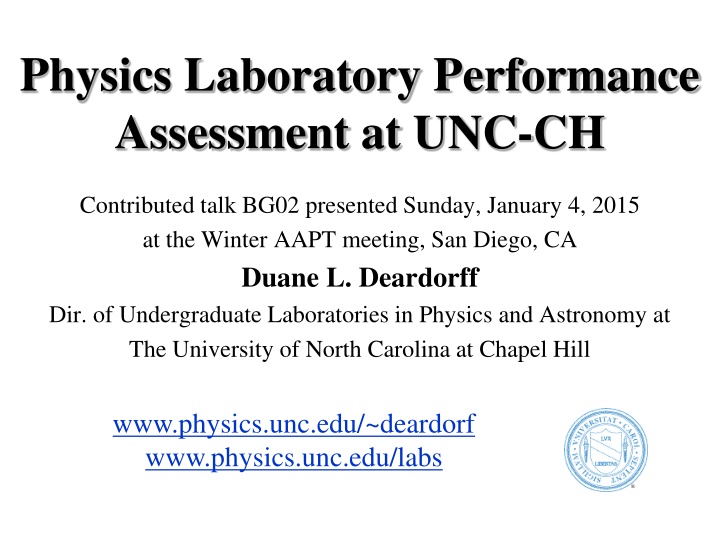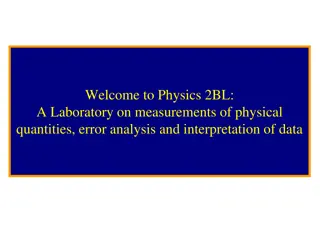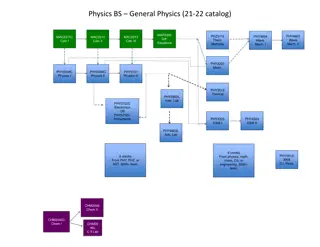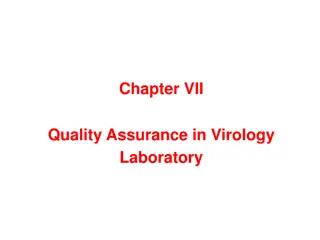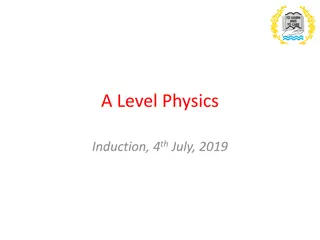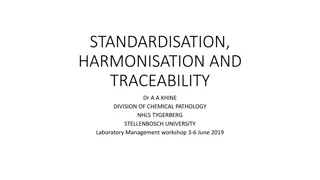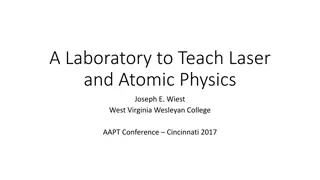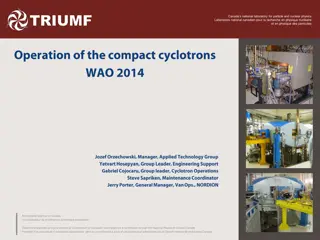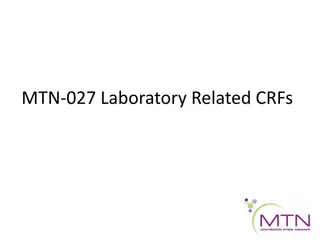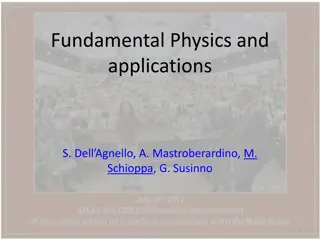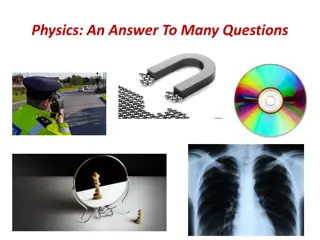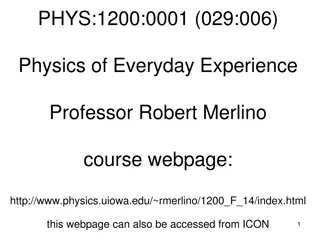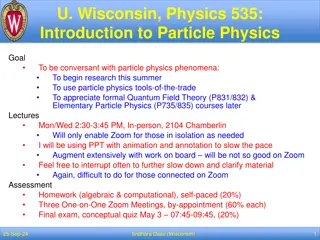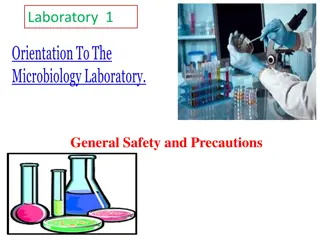Physics Laboratory Performance Assessment Overview
For over a decade, UNC-CH has conducted individual hands-on lab exams to evaluate students' lab skills and methodology in physics courses. The exams contribute significantly to the total lab score and course grade, ensuring thorough assessment of students' abilities to use lab equipment, analyze data, and draw valid conclusions. The exams serve various purposes, including enhancing teaching methods, identifying curriculum weaknesses, and improving score differentiation. Students work on written and hands-on exercises during the exams, aiming to demonstrate their proficiency in lab techniques and experimental design.
Download Presentation

Please find below an Image/Link to download the presentation.
The content on the website is provided AS IS for your information and personal use only. It may not be sold, licensed, or shared on other websites without obtaining consent from the author.If you encounter any issues during the download, it is possible that the publisher has removed the file from their server.
You are allowed to download the files provided on this website for personal or commercial use, subject to the condition that they are used lawfully. All files are the property of their respective owners.
The content on the website is provided AS IS for your information and personal use only. It may not be sold, licensed, or shared on other websites without obtaining consent from the author.
E N D
Presentation Transcript
Physics Laboratory Performance Assessment at UNC-CH Contributed talk BG02 presented Sunday, January 4, 2015 at the Winter AAPT meeting, San Diego, CA Duane L. Deardorff Dir. of Undergraduate Laboratories in Physics and Astronomy at The University of North Carolina at Chapel Hill www.physics.unc.edu/~deardorf www.physics.unc.edu/labs
Overview For the past 13 years, an individual, hands-on lab exam has been administered near the end of our introductory physics laboratory courses: Phys24 & 25 (algebra-based for bio, pre-med majors) Combined: N 500 students per semester Phys26 & 27 (calc-based for physics, comp sci, etc.) Combined: N 200 students per semester Labs are mostly traditional, experimental verification. Lab exam counts for 20% of total lab score, which is 25% of course grade. This is roughly equivalent to 2 lab report scores since there are 9 labs/course. A sample lab exam for each course (with answers) is on lab website so students know what to expect and can practice with equipment in Tutorial Center.
Why have a lab exam? Lab reports generally do not assess lab skills. Individual lab practicum provides incentive for all students to learn lab skills (not just hands-on learners). Help ensure that TAs teach proper methodology. To discover weak areas of curriculum and TA training that need improvement. Can be used as a proficiency exam for students trying to test out of lab. To improve discrimination of lab scores. (Some faculty complain that lab scores are too high, have narrow distribution, and are not consistent with course exam scores.)
Lab exam learning objectives Correctly use lab equipment to measure physical quantities. Correctly report each measurement with label, accurate value, reasonable uncertainty, sig. figs., and proper unit. Analyze experimental results and write a valid conclusion. Identify and explain choice of lab procedures used. Apply familiar experimental techniques to new situations. Determine final result and uncertainty from given data. Identify the primary source of error in an experiment. Properly construct graphs and interpret results. Design a simple experiment to measure a desired quantity.
Format Students work individually on written and hands-on exercises that are similar to tasks they (should) have already done in earlier labs. Open-book, open notes: students are allowed to use any resources except other people. The exams are designed to require about 1 hour, but students are allowed 2 hours (normal lab period) Sample lab exams with answers are provided on lab website. Equipment is available in Physics Tutorial Center for students to practice and get help. Lab exams are modified only slightly from semester to semester (usually only 1 or 2 questions are changed.) Students do not get to keep lab exam papers.
Instructions to Students Instructions:Work individually to complete each exercise to the best of your ability, show all your work, and clearly explain your answers in the spaces provided or on the back of these papers. Be sure to record all measurements (in SI units) and show all calculations. For items that require a numerical result, write your answer as you would for a formal lab report, including a meaningful label to identify a value. Your answer will be graded based on the accuracy of your result and proper reporting of uncertainty, significant figures, and units. Once the lab exam begins, you are not permitted to receive any assistance from your TA or other students. However, you may use your lab manual, graded lab reports, notes, and textbook as resources for this exam. The questions may be answered in any order, so adjust your work according to the availability of the lab equipment. Honor Pledge: All work presented here is my own. _________
Lab exam content - Mechanics Ranked roughly according to question weighting: 1. 2. 3. 4. 5. 6. 7. 8. 9. Use photogates to measure accel. of glider on air track Measure density of nickel coins. Are they pure nickel? Given time and distance data, find acceleration and xo. Use Vernier caliper to find radius of a steel ball Report best estimate of length of hall from 6 measurements Determine mass of rotating object from graphical results Calculate error from flag on air track glider rotated 20 Accuracy and precision of a simple pendulum How to report sin(80 1 )?
Lab exam content E&M Ranked roughly according to question weighting: 1. 2. 3. 4. 5. 6. 7. 8. 9. Connect circuit shown and measure currents with DMM. Use oscilloscope to measure time constant for RC circuit. Given a trace, find Vpp, Vrms, and frequency of signal. Calculate RT for 2 resistors (with 5% tolerance) in parallel Find n for block shown with refracted ray passing through. Given a converging lens, estimate its focal length. Given radioactive decay data, find half-life. Sketch graph of I vs V for light bulb that is non-ohmic. Given ammeter reading, report current value and uncert.
Grading A detailed rubric was developed on Excel for scoring by hand or by computer Grading takes ~5 min/student Objective grading except for explanations of procedures Measured values are generally considered accurate if they are within 2U of the median expert value, where U is the combined standard uncertainty (RSS of Type A and Type B components). Uncertainty values are generally acceptable up to 5*U Good reliability (avg. difference between graders is 2%)
Grading Target Weights Component Accurate values Units Uncertainty Significant figures Labels Procedures Explanations Weight 40% 15% 15% 10% 5% 10% 5% 100% Total =
Grading Typical Results Component Accurate values Units Uncertainty Significant figures Labels Procedures Explanations Weight 40% 15% 15% 10% Avg. Score 54% 79% 35% 48% 67% 85% 66% 5% 10% 5%
Historical Physics Lab Exam Averages 100 90 80 70 P24 P25 P26 P27 60 50 40 30 20 10 0 Fall 2001 Spring 2002 Fall 2002 Spring 2003 Fall 2003 Spring 2004
Historical Physics Lab Exam Averages 100 90 80 70 60 P104 P105 P116 P117 50 40 30 20 10 0 Spring 2011 Fall 2011 Spring 2012 Fall 2012 Spring 2013 Fall 2013
Historical Trends Average scores vary from semester to semester, but are mostly constant over time: ~65% (similar to course exam scores) Spread of scores (SD) each semester is consistent.~15% Slight decline in exam performance in recent years, not sure why. Apparently students are not cheating much from old exams! Exam is robust even without significant changes from year to year.
Typical results (Physics 105, Spring 2012) Conclusion: Scores do not increase or decrease throughout the week.
Correlation analysis for Phys24 Lab exam scores vs: R 0.3 - 0.4 0.5 - 0.6 0.4 - 0.5 Lab report scores Course exam average WebAssign homework Class participation 0.2 - 0.3 Conclusion: Lab exam does not duplicate lab report scoring, but it does correlate well with course exams. (Correlation between exam scores is ~0.5)
Conclusions The lab exam provides a rich set of research data. Lab exam and lab reports are different assessments together they give a more valid measure of a student s achievement. 90% of students responded that they felt the exam was fair - evidence of good content validity Motivates students (and TAs) to learn lab skills Opportunity to practice is important for student learning Faculty are generally pleased with lab exam and scores that are more consistent with course performance Student performance is not nearly as good as we would like for our students to achieve. We still have much work to do! Not surprisingly, performance depends on training and experience in class.
Links to Sample Documents Statement from lab manual and website Sample lab exams with answers Phys24/26 Lab Exam, Spring 2004 Grading rubric Phys25 Lab Exam, Spring 2004 Grading rubric Instructions for TAs
